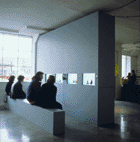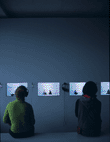
 |
| Nicola
Loder: The Art Of Conversation Andrea Tu |
||

|
The last few
years have seen an explosion of ‘Reality
Television’. Of course, what these programs give us
is not ‘reality’ at all, but cleverly edited
footage of ‘ordinary’ people putting on a bit
of a show for the rest of us watching at home.
Simultaneously banal, fascinating and repellent,
‘Reality Television’ has had us glued to the
set, beguiling audiences with its intensely voyeuristic
charms. The strange thing about it, other than some of
the personalities we’ve come to know, is the vague
sense that we are collectively engaged in watching a form
of entertainment with a curious resemblance to nature
documentaries, or more appropriately, ethnographic or
anthropological footage. Like any great David
Attenborough docu-drama, cameras have been placed in
prime positions, subjects coaxed into performing for the
camera, small melodramas staged, and the really boring
bits left on the cutting room floor. The difference is
that we are engaged in watching nothing more exotic or
exciting than ourselves. The language and codification of ‘Reality Television’ is borrowed from the documentary. Essentially expository, the documentary is supposed to possess truth and project reality, and as distinct from narrative film, it occupies an avowed status as non-fiction for non-theatrical use. The effectiveness of a documentary relies on the sincerity of the filmmaker and the participants not to fake it, but to show us the ‘truth’ in ‘good faith’. By trapping reality in a filmic image, its power lies in its apparently authentic representation of the actual, and the extraordinary way an image is able to ‘speak for itself’. According to Jean Rouche the camera was initially seen as “a kind of tool, which made the observation of man’s movements possible.”1 This basic notion is still with us, and seductively, it still seems enough to simply turn a camera on. An effective, if artless, agent in itself, the camera acts as a spur to action, and is a means through which to watch ourselves or others. Ethnographic film, as a form of documentary, initially began as a problematic way to capture on film the ‘disappearing’ culture of ‘others’. However by the 1960s and 1970s it had developed significant dialogical strategies in presenting the subjective voice in a positive way. Since then subjects have been given direct access to the camera, describing their personal experiences in the form of interviews or conversations with the filmmaker. Films that include dialogues with several people allow a more complex picture of a particular culture to emerge, and judgements about the reliability of testimony are left up to the viewer. By observing characteristic social interaction as well as conducting interviews with subjects we are given access to the emotional lives of people. This pursuit of the subjective voice is then thought to reveal the cultural basis of behavior. The goal is, hopefully, not to invade voyeuristically, but to observe social behavior, thereby illustrating from individual examples how culture exists as a collective identity that is engaged in a continuous process of interpretation and reinvention. Nicola Loder’s most recent untitled video work bears a resemblance to this style of scientific research and field footage. By turning the camera on a selection of her own acquaintances Loder has located her viewers inside the work as readers of their own culture. Made for the exhibition Orbital: Visions for a Future Australian Landscape, curated by Keely Macarow of Experimenta Media Arts, the work was exhibited at Lux Gallery, London and the Centre of Contemporary Photography, Melbourne during July 2000. It consisted of a series of hour-long video recordings of encounters and conversations between five pairs of people, all of whom knew the artist to varying degrees, but who had never met each other. As a group they reflected a conscientious range of sexes, ages and ethnicity, and like those presented on ‘Reality Television’ consisted of people we imagine that we might almost meet in our own backyard. Recorded from virtually the moment they set eyes upon each other, each pair of participants were left to make their own conversation until the hour was up. Each discrete segment was shot from a slight distance in exactly the same manner as the preceding one and left unedited. In exhibition form all of the conversations were screened on a row of monitors set into a wall with headphones hanging alongside. Loder used a clean white space or set in each segment, the effect when presented on screen being akin to that of a blank canvas—an undetermined space of possibility gradually anchored by the developing relationship between each pair. Visually, the contrast between the amorphous white glow of the set and the tangible materiality of the two individuals was quite beautiful. As direct access to the dialogue was minimized and close observation hindered, the gallery installation of the work tended to bring to the fore simple observations of movement and internal dynamics. To a certain extent the stylistic devices employed caused the paired strangers to be almost visually interchangeable, so that either or both of the interlocutors could easily have been substituted for somebody else entirely. However, the content of each discussion was clearly not transposable, each highly specific to the dynamics of that particular couple, existing as two autonomous individuals at that particular moment in time. Acting as a counterpoint to the strong aesthetic desires of the work, the dialogue was a reminder to the ‘realism’ of its content—some of the conversations were completely engrossing, others more akin to small talk. Clearly, some of the couples were better matched than others, but that some communed less easily didn’t, in the end, make much difference to the overall project. For a viewer, part eavesdropper and part spectator, the contrast between accessing the dialogue through the cocooning headphones and the accompanying sense of visual distance facilitated an ambiguous intimacy with, and alienation from, the subjects. There was a sense of containment and miniaturization—specimens had been collected and life histories gathered. The will-to-document fixed what was mobile into an immobility or finitude, those involved were suspended and their conversations framed as artifacts to be scrutinized. So what exactly did Loder present here? As a mode of documentation the work made apparent our deep-seated sociability, and the degree to which we define ourselves through social intercourse and communication. Yet the pursuit of the subjective voice and the simultaneous lack of any authorial voice or context raised other questions. Did we as an audience need more information than that the artist was willing to supply? How would an accompanying prologue and/or epilogue have affected our interpretation and our sympathies? What were the actual motivations in bringing these people together? Were these conversations the means to an end, or a fulfillment of them? The significant and possibly obvious thing about any footage of an existent person is that whilst they might be taken to represent broader sociological and historic terms, that specific footage is inescapably of and about them, and therefore a type of portrait. This and other video works similar to it are contemporary reinvigorations of the tradition of portraiture. Right from its inception the camera’s ability to quickly capture a physical likeness made miniature portraitists redundant. At first the large negatives and long exposure times of early cameras meant that sitters had to remain still, and so as Walter Benjamin observed “during the long duration of these shots they grew as it were into the picture.”2 Then more sophisticated technology ensured that a photograph could be taken in less than an instant, giving us the ubiquitous snapshot. Benjamin wrote: “Indeed, is not the homecoming amateur with his vast number of artistic snaps more contented than the hunter, returning laden with the game which is only of value to the trader. And indeed the time seems not far off when there will be more illustrated papers than game and poultry shops. So much for the snapshot.”3 Benjamin noted that no work of art as such in our era has been laden with as much attention and personal importance as the personal photograph. The reason? Photography’s concentration upon social function rather than aesthetic distinction. This is also true of video. Although possibly even more embedded in social function video, unlike the snapshot is a temporally dynamic medium. And so it is arguably the most viable means by which to give back what the modern portrait has always lacked—extension in and through time. Loder’s video work proffers all the emotional engagement of portraiture as it may be understood through dialogue or conversation. The subjective voice revealed is not that of the individual, but of two individuals communing with one another. The conversation is a means of mutually discovering something neither of the interlocutors knew when they began. As volunteered information, it is low-key dialogue that consists of an accretion of comments, disagreements and speculations. What arises during a conversation is not something that can be directed by either individual, but what is arrived at together. A conversation is a communication. And communication is not a message passed from one person to another like some kind of circuitous relay, but an exchange or interaction. Complex and subtle, to communicate is to identify and circumscribe what is held in common. For Maurice Blanchot the conversation is built upon an interruption, which permits the exchange. Interrupting for the sake of understanding, understanding in order to speak: “When two people speak together they speak not together, but each in turn: one says something, then stops, the other something else (or the same thing), then stops. The coherent discourse they carry on is composed of sequences that are interrupted when conversation moves from partner to partner, even if adjustments are made so they correspond to one another.”4 We do not communicate to make our differences apparent, but to underline our commonality. We do not speak to continue or outlast, but to break off. The conversation continually expects, indeed depends upon response. It is based in common speech, in language as connection. Under its domain lies the trivial and banal, the repetitive and fragmentary, but also the revealing and intimate. We can never transcend our relationships to observe, speak, or know from any wholly exterior point. We are always individuals immersed in communing with an other. Emmanuel Levinas bases the encounter of the self with other in a priority of the other. Alterity is that which is in excess, and eludes the subject’s desire to rapaciously seize it. The other’s absolute exteriority is what opens the subject up to the pursuit of knowledge. The ground of the encounter with the other is dialogue, and the conversation the means to understanding and realisation. And this is perhaps the final yearning of Loder’s work, a continual seeking of knowledge and understanding of the other, the desire for a truly contingent and extrinsic relationship with the other through which the social landscape may evolve, continuously. Andrea Tu Endnotes © The artist & |
|
 Nicola Loder, Strangely
|
||
 Nicola Loder, Orbital,
Centre |
||
 Nicola Loder, Strangely
|
||

|
||